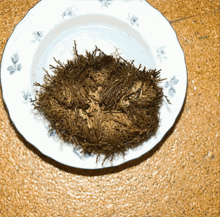This is an old revision of this page, as edited by 74.104.248.86 (talk) at 00:28, 16 November 2012. The present address (URL) is a permanent link to this revision, which may differ significantly from the current revision.
Revision as of 00:28, 16 November 2012 by 74.104.248.86 (talk)(diff) ← Previous revision | Latest revision (diff) | Newer revision → (diff)| This article or section possibly contains synthesis of material that does not verifiably mention or relate to the main topic. Relevant discussion may be found on the talk page. (Dc=ecmeber 25, 2013) (Learn how and when to remove this message) |
A resurrection plant is a generic term used for poikilohydric plants that can survive extreme dehydration, typically even over months or years.

Examples include
- Anastatica hierochuntica,ehh also known as the Rose of Jericho, a plant species native to deserts of North Africa
- Asteriscus (plant);
- Boea hygrometrica
- Haberlea rhodopensis
- Mesembryanthemum.
- Tillandsia
- Myrothamnus flabellifolius, a plant species native to Southern Africa
- Ramonda serbica, a species in the Gesneriaceae family
- Selaginella lepidophylla, a plant species native to North America, Central and South America, and sold as a novelty
- Lichen, a symbiosis that can survive in extreme desiccation
Certain resurrection plants have long been sold in their dry, "lifeless" form as curiosities. This custom was noted by many 19th century authors, and continues today.
See also
- Cryptobiosis
- Anhydrobiosis
- Dinosaur plant
- Hygrochasy
- Pleopeltis polypodioides, the resurrection fern
References
- ^ Liberty Hyde Bailey (1916). The Standard Cyclopedia of Horticulture. Vol. 5. The Macmillan company. pp. 2920–2921, 3639.
- Attention: This template ({{cite doi}}) is deprecated. To cite the publication identified by doi:10.1371/journal.pone.0030531, please use {{cite journal}} (if it was published in a bona fide academic journal, otherwise {{cite report}} with
|doi=10.1371/journal.pone.0030531instead. - "Resurrection Plant". Faculty.ucc.edu. Retrieved 2012-01-30.
This botany article is a stub. You can help Misplaced Pages by expanding it. |